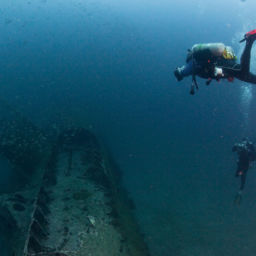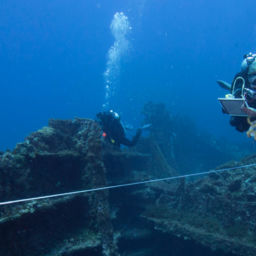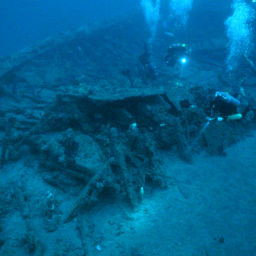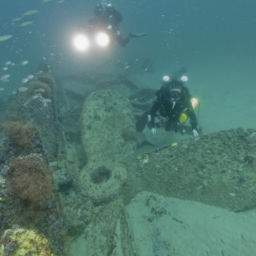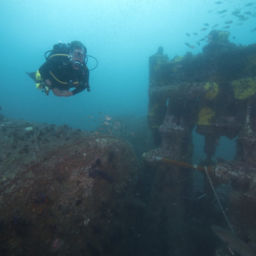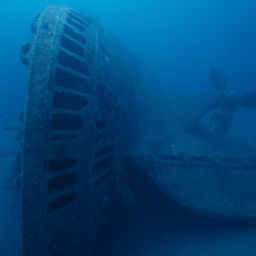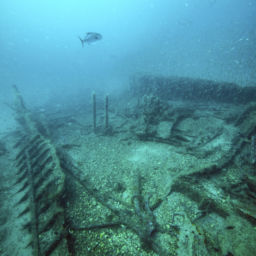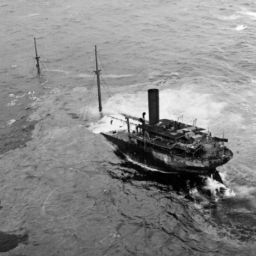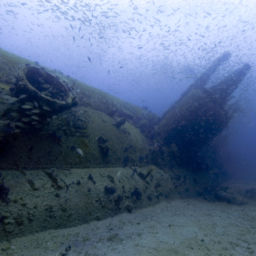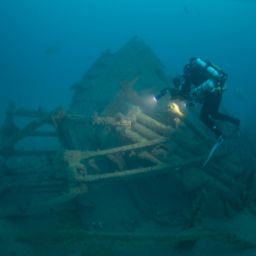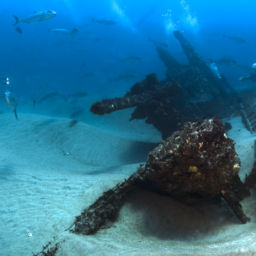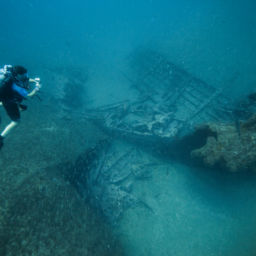From January to the end of August 1942, German U-boats attacked more than 285 vessels in North American waters. Just off coastal North Carolina, the remnants of many of these ships are scattered on the ocean floor. The remains of this little-known battlefield serve as the final resting place for 90 ships and nearly 1,700 men lost during the Battle of the Atlantic. Over the course of the battle, eight Allied convoy vessels, 78 merchant freighters and tankers and four German U-boats sank off North Carolina’s coast. Each shipwreck tells a unique story; today we visit the U-85.
U-85 sinks
Setting sail from St. Nazaire, France, on March 21, 1942, U-85 was making its third and final journey. With orders to patrol off the coast of the United States, the U-boat reached New Jersey and, on April 10, found its first target. Firing two torpedoes, U-85 sank the Swedish freighter Christina Knudsen, and then proceeded directly for Cape Hatteras, North Carolina.
Early in the day on April 13, USS Roper set out from Norfolk, Virginia, heading south to Cape Hatteras for antisubmarine patrol. Just south of Nags Head, North Carolina, U-85 waited in shallow water near the Bodie Island Lighthouse, looking for potential targets. Shortly after midnight, Roper approached the area where U-85 sat and detected a weak radar contact. At first, Roper’s crew didn’t suspect much, but they dutifully pursued the contact.
Sitting in very shallow water and knowing they were being tracked, the crew of U-85 decided to try to escape on the surface, hoping that their increased speed would get the U-boat into deeper water before Roper could attack. As Roper began to close in on U-85, the crew suspected that they were pursuing a submarine. Their suspicions came true when the crew witnessed the track of a torpedo narrowly missing the Roper as it ran down the port side. U-85’s attempt to shake Roper failed.
The gap between the two vessels closed, and a surface engagement ensued. Roper’s crew manned their machine guns and 3-inch deck guns. As the German sailors attempted to exit the conning tower to man their guns, they came under heavy fire from Roper’s crew. Roper not only had the advantage of more surface artillery but were also able to reach their guns sooner. A well-aimed 3-inch shell breached the pressure hull just aft of U-85’s conning tower.
U-85’s captain must have decided to scuttle and abandon the ship. As the U-boat began to sink at the stern, Roper’s crew watched the German sailors jump into the water and beg to be rescued. During this time, Roper believed it had another sonar contact and not wanting to take any chances of another possible U-boat, Roper rode right through the mass of sailors in the water and dropped an additional 11 depth charges. The depth charges killed the entire U-85 crew.
Roper returned after daylight and recovered the bodies of 29 sailors. The bodies were brought back to Norfolk and later that evening, they were buried in Hampton National Cemetery in Hampton, Virginia with full military honors under the cover of darkness. Today, visitors to the cemetery can see the graves and read the names of the sailors that were recovered.
Diving U-85
The wreck site of U-85 now rests in about 110 feet (34 m) of water 14 miles (23 km) east of Oregon Inlet along the Outer Banks. The visibility and water temperature vary widely depending on the dynamic, shifting currents. The wreck lies on its starboard side with approximately an approximately 80-degree list. The outer hull is gone at the bow, exposing the pressure hull and the four forward torpedo tubes. Some of these tubes still have visible torpedoes inside. Aft of the conning tower there is visible battle damage from Roper‘s 3-inch deck gun.
“Diving U-85 is the closest that many of us will come to experiencing what it was like during a World War II naval battle,” says NOAA archaeologist Tane Casserley. “You can clearly see the shell damage behind the conning tower caused by USS Roper‘s 3-inch gun. And with its 88-mm gun pointed toward the surface, U-85 looks like it’s still looking for Allied vessels to sink. It’s a truly haunting image.”
Learn more about U-85 and other World War II shipwrecks off the North Carolina coast here. There you’ll also find a 3D model of U-85, a photomosaic, a video, site plan, and dive slate.
An Expanded Sanctuary
In an effort to honor the service and sacrifice of those lost during the Battle of the Atlantic, NOAA in 2019 will release a draft proposal to expand the boundaries of Monitor National Marine Sanctuary to include a nationally significant collection of shipwrecks that currently have little or no legal protection. The expansion would also establish the largest area designated as a World War II battlefield anywhere in the world. HMT Bedfordshire is one vessel included in the proposal.
To learn more about the proposal, click here.









